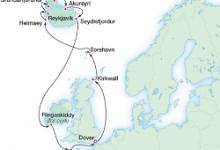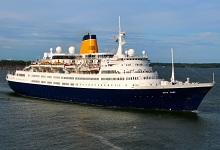Recently Viewed Cruises
- Saga Ruby, Ice Fire & Fjords ex Dover ReturnAdd to favourites
- Saga Sapphire, Land of the Midnight Sun ex Dover ReturnAdd to favourites
- Ortelius, North Spitsbergen Polar Bear Special ex Longyearbyen ReturnAdd to favourites
- Silver Explorer, Voyage 7215/7218/7313/7315 ex Longyearbyen to TromsoAdd to favourites
- Discovery, Summer Solstice & White Sea ex Harwich ReturnAdd to favourites
- Royal Caribbean International raises the bar
- Classy Astor fills gap in market
- Oceanic Discoverer
- Ab Fab Oosterdam
- Catch up on Cruising: Latest cruise news in bite size
- Frequently Asked Questions
-
Saga Ruby, Ice Fire & Fjords ex Dover Return
Nights 15 Ship Saga Ruby Star Rating 
Departs Dover England Sailing 2013: 19 Jun Ports of Call Dover England, Kirkwall, Tórshavn, Heimaey, Reykjavik, Grundarfjordur, Isafjordur, Akureyri More Seysdisfjordur, Cobh (Cork), St. Peter Port Please enquire about this cruise for pricing.
15 Night Cruise sailing from Dover roundtrip aboard Saga Ruby.
This cruise explores Iceland's wild fjords and ice-laden landscapes, as well as its stylish capital city, Reykjavik.
Highlights of this cruise:
Kirkwall
Located on Mainland, the largest of the Orkney Islands, Kirkwall's most striking feature is the 12th-century sandstone Norse St Magnus' Cathedral. This busy port is the gateway to some of Europe's finest archaeological sites, including the 5,000-year-old chambered tomb of Maes Howe, the mysterious Standing Stones of Stenness and the Stone Age Ring of Brodgar.
There's also a fascinating Stone Age village, that of Skara Brae, which was revealed after an especially fierce storm in 1850. With our choice of excursions you can visit some of the island's archaeological attractions, explore its rugged landscape or visit one of the world's most northerly and most famous whisky distilleries.
Torshavn
The Faroe Islands are situated in the North Atlantic, north-west of Scotland and half way between Iceland and Norway, and consist of 18 islands with only one uninhabited.
The focal point of life on the Faroe Islands, Torshavn, is one of the tiniest capitals in the world and is nestled on the southern flank of Streymoy Island. The town was named after the Viking god, Thor, when Norwegian Vikings settled the islands in AD800, and across the harbour lies Tinganes, the rocky peninsula where the ancient Vikings met.
Quiet fjords and sheltered bays provide safe anchorage for the fishing fleet and an idyllic location for pretty villages, where traditional timber, turf-roofed homes are lovingly maintained.
Heimaey
Heimaey is the largest and only inhabited island in the Westman Islands, which lie on a volcanic belt off Iceland's south coast. Slaves abducted from Ireland sought refuge here during the 9th century and as Ireland was the most westerly part of the known world at that time, they were referred to as west men, giving the island group its name.
Left mostly undisturbed by the outside world, Heimaey was raided in 1627 by Algerian pirates who took 300 people into slavery.
In 1973 a volcanic eruption destroyed much of the original town, but the fishing fleet, which was in harbour at the time, was able to take every member of the island's population to safety. Six months later, when the volcano had become dormant, most of the islanders returned to rebuild their homes and lives and re-establish Heimaey as one of Iceland's main fishing ports.
Reykjavik
Reykjavik, which translates as 'Smoky Bay', is the world's most northerly capital city. It has become increasingly popular in recent years, as more and more travellers discover its hotbed of geothermal activity, demonstrated by a range of extraordinary sights including eerie lava formations, bubbling geysers, hot springs, volcanoes and glaciers.
The town itself sprawls out from the harbour and has all the trappings of a progressive European city fused with a beautiful old town, which boasts colourful architecture, whitewashed buildings and narrow streets. Our selection of excursions also explores the surrounding areas, from desolate moorland, thriving national parks and picturesque lakes, all imbued with beguiling folkloric legend.
Isafjordur
Formerly one of Iceland's main trading ports and sheltered by mountains on three sides, Isafjordur remains the largest settlement in the Westfjords region and offers spectacular scenery, with rock formations that are up to 14 million years old.
The Westfjords region is separated from the mainland by an isthmus six miles across, which according to local legend was built by three trolls who wanted to live apart from humans. The harsh environment is home to an array of wildlife including the arctic fox, seals, whales and huge colonies of seabirds.
Akureyri
Named after the Akureyri, one of the numerous spits of land in Pollurinn, the capital of northern Iceland was originally settled by Vikings during the ninth century AD. Danish merchants later based their summer camps here and in 1778 the town was granted a municipal charter by Denmark.
The outstanding natural harbour and productive agricultural region surrounding Akureyri fostered the development of the town and today's visitors will find a wealth of entertainment and attractions including museums, lovely botanical gardens and the church.
Akureyri has a robust cultural scene, with several bars and reputable restaurants, such as Greifinn, Bautinn, RUB 23 Steak/Sushi and Cafe Karolina. The Icelandic folk dance ensemble "Vefarinn" comes from Akureyri. Folk culture in general is more prevalent in Akureyri than in Reykjavik. During the summer there are several festivals in Akureyri and its surroundings. One example is the medieval festival held every summer at Gasir.
St Peter Port
With its magical mix of French and English culture, Guernsey is the second largest of the Channel Islands. It is renowned for its friendly atmosphere, temperate climate, fascinating history and rich natural heritage.
St Peter Port, the island's bustling capital and the oldest community in the Channel Islands, lies on the east side, hugging the slopes that rise back from the sea so that the houses appear to be piled on top of one another. Endearingly quaint and well preserved, this pretty port has neat rows of Victorian, late-Georgian and Regency architecture, plus numerous cobbled streets and steep alleyways to explore.
Sleek yachts and fishing boats shelter in the harbour which is overlooked by 13th-century Castle Cornet, from where the noon-day gun is fired every day.







